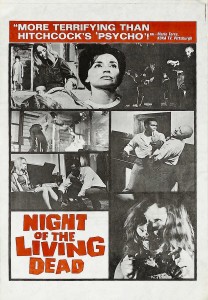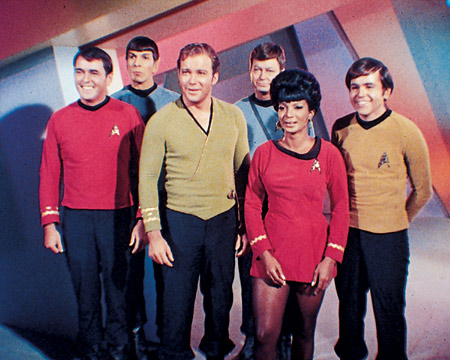 In honor of Black History Month, I wanted to take a glimpse at how far we’ve come as a society regarding the inclusion of African Americans in the sci-fi genre. This is a topic I addressed with three of my fellow authors during a science fiction panel discussion at the Harlem Book Fair last summer. In order to see how far we’ve come and speculate where we’re going, it’s important to analyze where we’ve been. Though much was covered during the discussion, my fellow authors and I only scratched the surface of this vast topic. After all, it’s quite a challenge to sum up over half a century’s worth of progress in just an hour.
In honor of Black History Month, I wanted to take a glimpse at how far we’ve come as a society regarding the inclusion of African Americans in the sci-fi genre. This is a topic I addressed with three of my fellow authors during a science fiction panel discussion at the Harlem Book Fair last summer. In order to see how far we’ve come and speculate where we’re going, it’s important to analyze where we’ve been. Though much was covered during the discussion, my fellow authors and I only scratched the surface of this vast topic. After all, it’s quite a challenge to sum up over half a century’s worth of progress in just an hour.
The specific title of the panel was Black to the Future: Why We No Longer Die First in Sci-fi Movies. The aim was to analyze the evolution of the inclusion of African Americans in the genre, not necessarily just film alone. My fellow panelists and I discussed our theories as to why black characters were often used as cannon fodder in the genre and what has changed between then and now. My assessment is that the extent of the representation of minorities was reflective of society at the time since there was a struggle for blacks to gain equality and acceptance. In reality, the future of black Americans was uncertain, so in many ways it makes sense that the studios didn’t see a future for this portion of the population in the fictional world either. It was also likely that the executives didn’t want to challenge what had become a familiar way of life, perhaps out of fear of protest or potential loss of revenue.
 That’s not to say that this was a unanimous outlook among all the studios. George A. Romero’s independent film Night of the Living Dead (1968) boldly featured Duane Jones, an African American, in the lead role in what would become a cult classic zombie film and pave the way for such hits as the Walking Dead. Mr. Jones didn’t portray the villain, nor a subservient character, but rather a take-charge hero and not once was the subject of race brought up in the film. The main focus was on the fact that a group of strangers were thrust together in their pursuit of survival. Remarkable, given the social tensions of that era.
That’s not to say that this was a unanimous outlook among all the studios. George A. Romero’s independent film Night of the Living Dead (1968) boldly featured Duane Jones, an African American, in the lead role in what would become a cult classic zombie film and pave the way for such hits as the Walking Dead. Mr. Jones didn’t portray the villain, nor a subservient character, but rather a take-charge hero and not once was the subject of race brought up in the film. The main focus was on the fact that a group of strangers were thrust together in their pursuit of survival. Remarkable, given the social tensions of that era.
Two years prior to Romero’s accomplishment, Gene Roddenberry put forth his vision of a culturally balanced future by casting a black woman, a Japanese man and a Russian in his Star Trek (1966) series. A bold move considering the Civil Rights Movement and the Cold War were still in progress. Night of the Living Dead and Star Trek both went on to become huge successes and proved that although a portion of the population had become complacent with segregation, the majority of audiences weren’t as unanimously biased as the executives may have believed.
Still, there have been setbacks along the way. When I was growing up, there was sort of a running joke as to who would die first in a sci-fi/horror film. Usually, it was the character with the most melanin. And if the character wasn’t killed off, chances were they’d be insignificant or would become the victims of racial stereotyping. What was the reason for these setbacks? I’ll elaborate more on this next week in part two of this blog.
For now, I’ll wrap up by saying that although there is still a disproportionate cultural representation in the genre, there’s no denying the remarkable strides that we, as a society, have made between the late-sixties and today. Such progress couldn’t have been achieved without vision, passion and a collaborative effort to spark change. With the age of technology there’s no doubt that we can go even further, as long as we work together.
Click here to watch a video of some of the highlights from the 2012 Harlem Book Fair sci-fi panel discussion.


I agree with your points, Shykia. I wonder, however, how long it will be before the giants in the SF genre will write in people of color as mainstays in their story themes. A few already have, but it’s a shame that they are models. I often ask myself, ‘How could I write a story, when every time I leave my house I see people of varying heritages, and not incorporate them in every theme I pursue?’
Great post.
My apologies for the late reply, A.T.. I’m so glad you enjoyed my post. I agree with your sentiment. Hopefully, it won’t be long before we see an increase in central non-stereotypical characters of color in sci-fi roles. To me, it’s just common sense that art and entertainment reflect our diverse culture.
Shykia, great and informative post. It’s encouraging to realize that acceptance and cultural inclusion of minorities is taking place in all parts of society. We still have a ways to go though, but things are changing for the better.
Thanks for sharing!
Christa
Sorry for not replying sooner, Christa. Thanks for your comment. I’m glad you enjoyed my blog. Yes, I consider myself blessed and fortunate to live in a time where our society is at its most culturally inclusive. I agree with you in that we still have a ways to go.